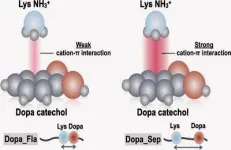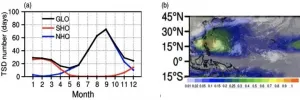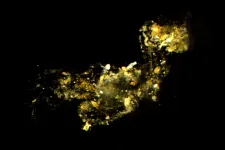Scientists identify protein that activates plant response to nitrogen deficiency
2021-06-01
(Press-News.org) Nitrates are critical for the growth of plants, so plants have evolved sophisticated mechanisms to ensure sufficient nitrate uptake from their environments. In a new study published in Nature Plants, researchers at Nagoya University, Japan, have identified a plant enzyme that is key to activating a nitrate uptake mechanism in response to nitrogen starvation. This finding explains how plants meet their needs in challenging environments, opening doors to improving agriculture in such environments.
When nitrate levels are plentiful in a plant's environment, a plant can achieve adequate nitrate uptake levels by relying on what plant biologists call a "low-affinity transport system." But when nitrates become scarce in a plant's local environment, it may need to switch to a more powerful nitrate uptake mechanism known as a "high-affinity transport system." In Arabidopsis plants, which frequently serve as model organisms for plant biology research, the NRT2.1 protein plays an important role in the high-affinity transport system. Interestingly, when Arabidopsis plants synthesize the NRT2.1 protein, they initially produce an inactive protein that can later be activated when the high-affinity transport system is needed.
This synthesis of a nonfunctioning protein that can later be activated intrigued Dr. Yoshikatsu Matsubayashi of Nagoya University, but he sees a certain logic in this preparatory protein synthesis; he notes, "Proteins cannot be synthesized when the nitrogen deficiency occurs." In other words, plants need to synthesize the proteins in a high-affinity transport system before a nitrogen deficiency necessitates the use of those proteins, because nitrogen deficiency itself makes it difficult to synthesize new proteins. In order to better understand this remarkable system, Dr. Matsubayashi and his colleagues set out to identify the protein that activates NRT2.1 in response to nitrogen starvation.
Previous studies had shown that a peptide called CEP found in plant roots plays an important role in activating biochemical pathways that respond to nitrogen starvation, so the researchers focused their investigation on the CEP and its downstream CEPD pathway. Their experiments soon drew their attention to a protein called At4g32950. The researchers found that this protein responds to nitrogen starvation by activating the NRT2.1 protein. It achieves this activation by removing a phosphate group from a specific location on the NRT2.1 protein, so the investigators decided to give the At4g32950 protein a new name: CEPD-induced phosphatase, or "CEPH" for short.
CEPH is found mainly in the cells close to the surface of the Arabidopsis plant's roots, which is an optimal location for activating a system that evolved for rapid nitrate uptake from the environment. As expected, using laboratory methods to inactivate the gene that encodes CEPH impaired the ability of Arabidopsis plants to use the high-affinity transport system for rapid nitrate uptake, and this meant that the modified plants had lower internal nitrate levels and grew to smaller sizes.
Collectively, these results indicate that CEPH plays a critical role in responding to nitrogen starvation through its activation of the NRT2.1 protein. Dr. Matsubayashi sees considerable potential utility in CEPH as a genetic engineering tool, as he notes, "Artificially enhancing CEPH activity could enable scientists to create plants that grow even in soils with low nutrient levels." Such findings could change the way agriculture and food security are handled.
INFORMATION:
The paper, "A type 2C protein phosphatase activates high-affinity nitrate uptake by dephosphorylating NRT2.1," was published in the journal Nature Plants on March 8, 2021 at DOI: 10.1038/s41477-021-00870-9.
About Nagoya University, Japan
Nagoya University has a history of about 150 years, with its roots in a temporary medical school and hospital established in 1871, and was formally instituted as the last Imperial University of Japan in 1939. Although modest in size compared to the largest universities in Japan, Nagoya University has been pursuing excellence since its founding. Six of the 18 Japanese Nobel Prize-winners since 2000 did all or part of their Nobel Prize-winning work at Nagoya University: four in Physics - Toshihide Maskawa and Makoto Kobayashi in 2008, and Isamu Akasaki and Hiroshi Amano in 2014; and two in Chemistry - Ryoji Noyori in 2001 and Osamu Shimomura in 2008. In mathematics, Shigefumi Mori did his Fields Medal-winning work at the University. A number of other important discoveries have also been made at the University, including the Okazaki DNA Fragments by Reiji and Tsuneko Okazaki in the 1960s; and depletion forces by Sho Asakura and Fumio Oosawa in 1954.
Website: http://en.nagoya-u.ac.jp/
[Attachments] See images for this press release:

ELSE PRESS RELEASES FROM THIS DATE:
2021-06-01
Oxygen (O2) is an essential gas not only for us and most other lifeforms, but also for many industrial processes, biomedicine, and environmental monitoring applications. Given the importance of O2 and other gases, many researchers have focused on developing and improving gas-sensing technologies. At the frontier of this evolving field lie modern nanogap gas sensors--devices usually comprised of a sensing material and two conducting electrodes that are separated by a minuscule gap in the order of nanometers (nm), or thousand millionths of a meter. When molecules of specific gases get inside this gap, they electronically interact with the sensing layer and the electrodes, altering measurable ...
2021-06-01
The Yakushima sika deer (yakushika: Cervus nippon yakushimae), a subspecies of the Japanese sika deer (Cervus nippon), evolved without natural predators on the island of Yakushima, in Kagoshima Prefecture, Japan. It inhabits the forests on the island which were declared a World Heritage Site in 1993. Within the site, the yakushika has not been hunted in the past 50 years; however, since 2014, their population has been decreasing. This phenomenon is especially curious, as Japanese researchers believed that sika deer populations in Japan would not decrease without human intervention.
A group of three scientists, including Hokkaido ...
2021-06-01
Led by the University of Sydney's Charles Perkins Centre, the study looked at medical data from nearly half a million people and found having overweight or obesity considerably amplified the harmful effects of alcohol on liver disease and mortality.
"People in the overweight or obese range who drank were found to be at greater risk of liver diseases compared with participants within a healthy weight range who consumed alcohol at the same level," said senior author and research program director Professor Emmanuel Stamatakis from the Charles Perkins Centre and the Faculty of Medicine and Health.
"Even for people who drank within alcohol guidelines, participants classified as obese were at over 50 percent greater risk of liver disease."
The researchers ...
2021-06-01
Mussels survive by sticking to rocks in the fierce waves or tides underwater. Materials mimicking this underwater adhesion are widely used for skin or bone adhesion, for modifying the surface of a scaffold, or even in drug or cell delivery systems. However, these materials have not entirely imitated the capabilities of mussels.
A joint research team from POSTECH and Kangwon National University (KNU) - led by Professor Hyung Joon Cha and Ph.D. candidate Mincheol Shin of the Department of Chemical Engineering at POSTECH with Professor Young Mee Jeong and Dr. Yeonju Park of the Department ...
2021-06-01
Nearly two billion people live in a region where tropical cyclones (TC) are an annual threat. TCs are deadly and can cause billions of dollars in economic losses worldwide. During peak season in the Northern Hemisphere, typically July through October, about two TCs develop or are ongoing every day. However, this and overall TC frequency vary substantially year-to-year.
To quantify this variability, scientists developed a metric called the tropical storm day (TSD). TSD is a collective measure of how frequently tropical cyclones develop, storm track, and cyclone lifespan, which reflects overall activity. Despite this advancement, researchers have not often studied tropical cyclone variability on a global scale.
Now, ...
2021-06-01
In a paper published in NANO, researchers from Guizhou Meiling Power Sources Co., Ltd., China have reviewed the recent progress in biopolymer-based electrolyte. The biopolymer materials with unique characteristics including water solubility, film-forming capability and adhesive property played a key role in the design of zero pollution lithium battery. The biopolymers mentioned in this review were polysaccharide, protein, natural rubber and other polymers.
For polysaccharide, cellulose with good wettability, low cost and good mechanical properties can enhance the mechanical strength of membranes and improve interfacial stability between electrolyte and electrode. However, the porosity control of cellulose-based membranes was ...
2021-06-01
Habitat change, for example through urbanisation, is one of the most important causes of biodiversity decline. By 2050, settlements and cities across the globe are predicted to increase by two to three million square kilometres - about half the size of Greenland. Natural and semi-natural habitats will thus gradually be replaced by urban habitats.
How wildlife can adapt to such fundamental changes has mostly been studied for a few species groups, such as mammals and birds.
"In order to make predictions about the development of biodiversity as a whole and to combat current phenomena such as insect declines, robust knowledge is also needed for other species groups," ...
2021-06-01
To realize tritium self-sustaining cycle through tritium breeding blanket has been one of the core technologies of future fusion reactor. Therefore the design and function of blanket must be validated by neutronic experiment under D-T neutron environment. But due to the scarcity of DT neutron source, and highly radioactivity during neutronic experiments, it is very difficult to validate the nuclear response of the blanket, the data of tritium production rate mainly rely on Monte Carlo simulation.
Recently, a research group led by ZHU Qingjun from Institute of Plasma Physics, ...
2021-06-01
As anyone who has ever procrastinated knows, remembering that you need to do something and acting on that knowledge are two different things. To understand how learning changes nerve cells and leads to different behaviors, researchers studied the much simpler nervous system of worms.
"In this study, we can now translate neuronal activity to behavioral response," said Project Researcher Hirofumi Sato, a neuroscientist at the University of Tokyo and first author of the research paper recently published in Cell Reports.
The discovery was made possible using technology that researchers describe as a "robot microscope," first developed in 2019 by researchers at Tohoku University in Miyagi Prefecture, northeastern Japan.
The technique involves genetically modifying the worms ...
2021-06-01
A team of scientists from the Max Planck Institute for Marine Microbiology, the Max Planck Institute for Meteorology and the GEOMAR - Helmholtz Centre for Ocean Research Kiel have been studying biogeochemical processes in the oxygen minimum zone of the eastern South Pacific off Peru, one of the largest low oxygen regions of the world ocean. The researchers focused on so-called marine snow particles of different sizes, which are composed of algal debris and other organic material, aiming to understand how these particles affect the nitrogen cycle in the oxygen minimum zone. Thereby, they solved ...
LAST 30 PRESS RELEASES:
[Press-News.org] Scientists identify protein that activates plant response to nitrogen deficiency







